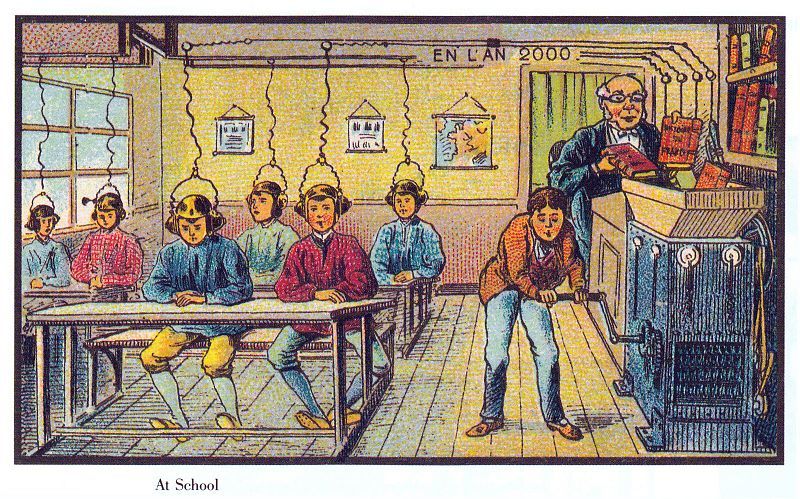What Lies Ahead
by Kim Pederson…….
At the end of the 19th century, French commercial artist Jean-Marc Cote created a series of illustrated cards envisioning what the world would be like in the year 2000 (see examples here). Besides the classroom shown below, where the teacher grinds up books and feeds them electronically into students’ heads, Cote foresaw things like flying firemen, whale-powered submarine commuting, an electric floor scrubber, and a mobile home. These cards were first put in cigar and cigarette boxes and then printed as postcards. Science fiction writer Isaac Asimov famously stumbled on and bought a complete set and then reproduced them in his nonfiction book Futuredays (described by Kirkus Reviews as a “featherweight non-book” — but hey, we need those sometimes, don’t we?).

I stumbled myself (something I do often) on the image above in Time Travel, the James Gleick book I’ve been reading. Gleick describes these cards as “prescient images” He notes that, while the practice of prophecy (as in fortune telling) is ancient, previous to this time “no one asked the oracle to forecast the character of daily life in years to come.” With H.G. Wells’ The Time Machine, the ideas of “futurity” and “futurism” came into vogue. These refer to, in Asimov’s view, what Gleick describes as “a sense of the future as a notional place, different, and perhaps profoundly different, from what has come before.” He then quotes Isaac directly: “It may seem to us that the potential existence of such a future is self-evident, but that was most definitely not so until comparatively recent times.”
When I saw the school image above, I remembered that an outtake from it appeared on the t-shirts and other paraphernalia sold when the 2012 Key West Literary Seminar, titled “Yet Another World: Literature of the Future,” focused on science fiction. The seminar was cool, the authors interesting panelists and speakers, and Kalo and I got to sit at the same table with William Gibson at the closing night dinner. Gibson, author of Neuromancer and other well-known works, is described as a writer of speculative fiction. Science fiction, I guess, is now de rigueur, which makes sense because not all visions of the future involve science.
So have we come a long way with regard to how we view the future? Perhaps the pre-Time Machine world, being “nowists” instead of “futurists,” had the better idea, that is, why spend time imagining something you can imagine but can never imagine correctly? Gibson captures this thought much better than I can in his novel Pattern Recognition [long quote warning–sorry]:
We have no idea, now, of who or what the inhabitants of our future might be. In that sense, we have no future. Not in the sense that our grandparents had a future, or thought they did. Fully imagined cultural futures were the luxury of another day, one in which “now” was of some greater duration. For us, of course, things can change so abruptly, so violently, so profoundly, that futures like our grandparents’ have insufficient “now” to stand on. We have no future because our present is too volatile…. We have only risk management.
The idea of our future being nonexistent because the present is too volatile is undeniably relevant and frightening these days, and the safeguard of risk management, if it is a safeguard, is getting shakier every minute. Our future, in Gibson’s words, “is there…looking back at us” from the news media screens, assuring us that our fate is safe in his not-small-but-large hands. In this case, “he knows not what he says” seems a huge understatement. While a benevolent god might forgive him this, will we? Should we? Can we? Who knows? What I do know is that old saw about living in the now, even though we can never really do this (stay tuned–to be explained), seems the best advice at this moment and, for me, that means lunch, which is something, unlike most other things, that one can, and does, imagicipate [imagine with anticipation] with pleasure. And you thought, I’ll bet, that this would not end on a positive note.
* France in 2000 year (XXI century). At school. France, paper card. Public domain.
~~~~~~~~~~
Visit Kim Pederson’s blog RatBlurt: Mostly Random Short-Attention-Span Musings.


Facebook Comments